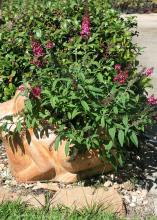Information Possibly Outdated
The information presented on this page was originally released on October 6, 2014. It may not be outdated, but please search our site for more current information. If you plan to quote or reference this information in a publication, please check with the Extension specialist or author before proceeding.
Flutterby butterfly bushes bring fall butterfly guests
Probably every gardener enjoys the fall season with cooler weather and extra butterfly activity. If you’re one who can’t get enough of the butterflies, you should consider including one of my favorites, the butterfly bush, in your landscape.
Butterflies and even hummingbirds love the flowers of this plant, which is known botanically as Buddleia.
Butterfly bushes have a loose growing habit that I think looks best if left unpruned, but I understand that some plants get a little unruly and need tidying up. Flowers are sweetly fragrant clusters of tiny blooms in shades of white, blue, purple, pink, red and even yellow. The flowers are displayed on arching, graceful stems.
The butterfly bush is a great selection for Mississippi gardens and landscapes because it tolerates hot, humid summers and the inevitable dry spells. If you don’t have an irrigation system, just water yours deeply a couple of times a month during these times.
Typically, butterfly bushes can be rather large plants in the landscape. It’s not unusual for some species to be bigger than 6 feet tall and wide by the end of summer. I’ve grown big, beautiful butterfly bushes in my landscapes as my wife and I have moved around the country.
But I’ve got to let you in on a relatively new trend in butterfly bushes -- compact growing plants. The Flutterby series was one of the first of these to hit the market. It grows 3 to 4 feet tall with dense branching, and it flowers all summer long.
Some people thought even these plants were too big, so along came the Flutterby Petite series. These plants have dwarf growth habits that make them perfect for ground cover use, small gardens and containers. I never thought butterfly bushes could be used as a thriller plant in a combination container, but you should try one and see how it works.
Colors include pink, fuchsia-pink Tutti Frutti and purple-blue Blue Heaven. My wife and I are currently growing a Tutti Frutti in a large container, and we have not pruned it at all. This plant has flowered all summer, despite us not even deadheading faded flowers. A special treat is the scent the foliage gives off as I brush by.
Butterfly bushes have few pests, but they may get spider mites. Use the hose to give the foliage a hard spray to discourage the pests. Use insecticides with care, as you don’t want to harm the butterflies the plant invites to your yard. Plant in full sun for best flowering, as shade reduces flowering and the plant becomes thin and leggy.
I really like these plants in containers, but you can also plant Flutterby Petite plants in the ground. They tolerate just about any soil type as long as it’s well drained. These plants grow best in a slightly alkaline soil. If the soil pH is below 7.0, apply a couple of handfuls of dolomite to the soil when planting. Fertilize sparingly, as overfertilization can reduce winter hardiness.
One last thing to remember for next spring: Butterfly bushes are among the last plants to wake up. I get quite a few calls each year from homeowners asking me if their butterfly bushes are dead. My advice is to be patient. I haven’t lost a patient yet.








